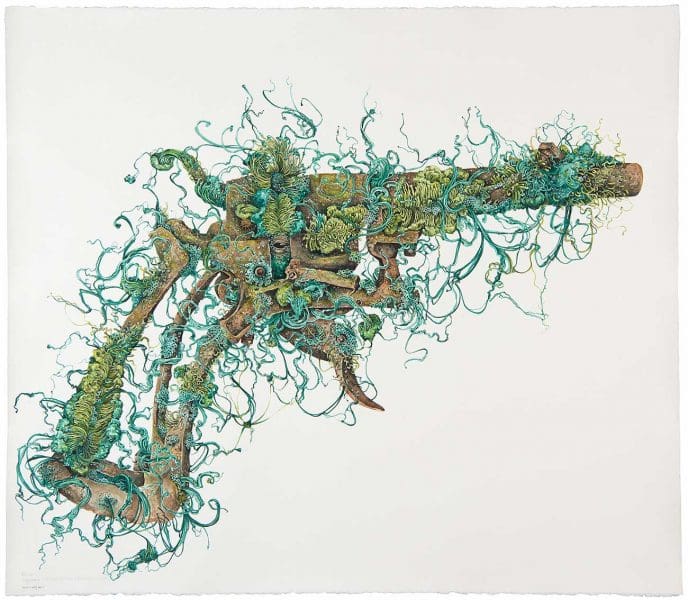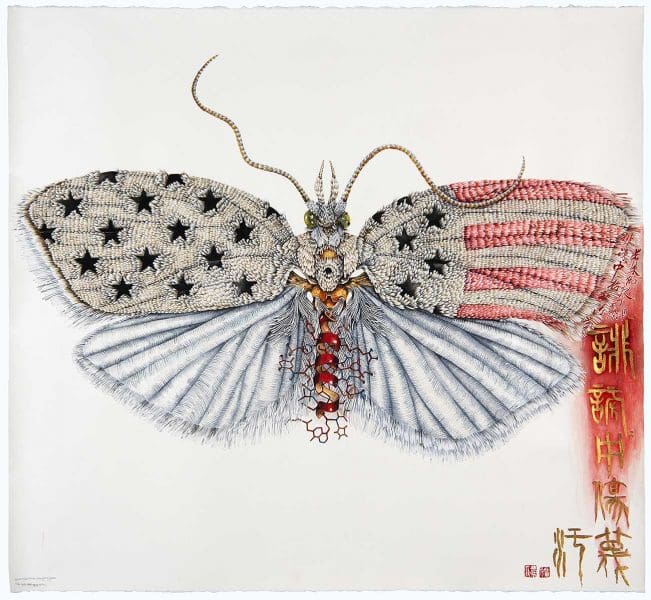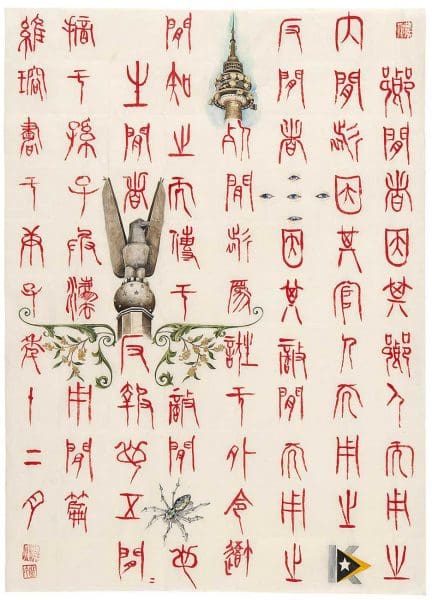
Piercing the veil
A new exhibition at Buxton Contemporary finds a rich complexity in the shadowy terrain between life and death.

eX de Medici, ‘Tear Gas’, 2020, watercolour, body colour (white) and gold leaf on paper, 114cm x 124.5cm.

eX de Medici, ‘Verdigris Vincent’, 2020, watercolour on paper, 114cm x 130cm.

eX de Medici, ‘Covid’s Eyes‘, 2020, watercolour and body colour (white) on paper, 114cm x 119.5cm

eX de Medici, ‘Mustard Cyanide‘, 2020, watercolour, body colour (white) and gold leaf on paper, 114cm x 124.5cm
Before she became one of Australia’s most respected artists, eX de Medici was both a punk and a tattooist. The iconoclastic energy of the former, and the technical precision of the latter, can still be seen in the Canberra-based artist’s watercolour paintings, which combine delicate detail with bold social critique. Here, eX de Medici’s tells us about the symbolism and hybridity of her work.
Tracey Clement: You worked as a tattooist for many years. How has this experience shaped your practice as a painter?
Ex De Medici: It takes years, lifetimes, to learn any medium in depth. Tattooing requires a particular skillset. It is precise, miniature. Mistakes are inexcusable, every millimetre must be attended to, and, importantly, a tattooist works entirely for someone else. I still do some work in the medium with people whose ideas interest me.
TC: Your work is so redolent with symbols that it is often compared to Dutch still life painting. Is this a genre you consciously draw on?
XDM: The 17th century European stilllife genre has been a powerful influence. In 1997 I travelled to the Rijksmuseum in Amsterdam to research this tradition. I was enthralled by the impossible surfaces, the precision of masking intent via symbolism—a great achievement also employed by contemporary Iranian artists—and the eternal night of the objects represented.
These same qualities draw me to Islamic and European illuminated manuscripts, Tudor portraiture, Holbein’s paintings and woodcuts, and Ferdinand Bauer’s perfections of the natural world.
TC: Your work often deals with hybridity—two things combining to make something new. One of the very first pieces I wrote as an art critic was on your Blue (Bower/Bauer) painting, 1998- 2000. I remember noting the symbolism of the broken willow-pattern plate, a classic example of hybridity…
XDM: Blue (Bower/Bauer) was an exploration of the ongoing colonisation project that is Australia. The willow pattern is a classic example of [Western] Empire’s cultural and economic hijacking of tradition—in this case, Chinese ceramics.
The broken willow-patterned plate references Thomas Stothard’s depiction of the departure of the women’s convict transport ship, the Lady Julian(a). My parents’ common ancestor, Mary Wade, was an 11-year-old child prisoner aboard this ship. Her death sentence in London was commuted to life in the colony. On arrival in Sydney, she was transferred to the Norfolk Island gulag.
Austrian botanical illustrator Ferdinand Bauer produced a large body of work on the island, and I visited in 1996 and 1997, for three weeks each trip, in order to research elements of Blue (Bower/Bauer).

TC: Some 20 years later you are still working with hybridity. Your latest solo show, Double Crossed, features impossible creatures: part moth, part weapon.
XDM: Nothing is singular; hybridisation increases complexity. Worlds run beside each other, crossing, colliding, uncrossing. Unlikely and unrelated can be cleaved together by persuasion.
TC: One of these hybrid moths, titled Covid eyes, has a body made from, or infected with, the distinctive coronavirus shape.
XDM: All of the [moth] species group in Double Crossed are unclassified but known as a subspecies of the micro Lepidoptera superfamily, Tortricidae.
In my mind, I call this subspecies ‘Eyes of Buddha’, as the forewing pattern has a remarkable simulacrum to the Tibetan Thangka painting tradition of depicting the deity’s eyes. This picture was begun at the onset of the national lockdown in early 2020, so I gave the ‘Eyes of Buddha’ a Covid infestation. Aside from Covid isolation, artists have trained all our lives for this moment…I loved the lockdown. It worked. It was great.
TC: For some 20 years now you’ve been working with the CSIRO-managed Australian National Insect Collection (ANIC), under the guidance of taxonomists and evolutionists Dr Marianne Horak and Ted Edwards. How did this begin?
XDM: I was introduced to them by a mutual friend and artist, Lee Anne Crisp. I was merely looking for a blue species of butterfly endemic to Norfolk Island to add to Blue (Bower/Bauer), and was fascinated with the quiet, obsessive, welcoming and secure atmosphere of the Collection Halls at the Black Mountain CSIRO facility, the internationalist taxonomists and field scientists, and the gigantic world of our fauna (and therefore, our flora).
Marianne and Ted welcomed me into their world, so I went on in, taking instruction from my mentors, learning the traditions of natural history painting and picking up some basic scientific language in which to define what I was looking at. The micro-moths are convenient to discuss dual evolutionary pathways of the natural world and human dominance. I have been open to entering unforeseen pathways throughout my working life.
TC: Having access to the specialist knowledge of Horak and Edwards has clearly had an impact on your work. What effect do you think having an artist around has had on them?
XDM: We have developed a symbiotic relationship. Science and art have vast historical ties. Artists, like scientists, are well trained in two occupational necessities: pattern recognition and curiosity. We are not enemies, as our government would have us believe.
Marianne loves seeing the tiny moths she collected as a young Swiss scientist in New Guinea in the early 1970s have their first translation into the world.
And I hope that over the years I have worked with the CSIRO I have been able to make a contribution to a broader understanding of the organisation’s valuable ongoing work in our knowledge of the extraordinary biodiversity and delicacy of our region.

TC: In 2019 you travelled to China and made a large collaborative landscape painting, Farmer and Foreigner, with fellow artist Wei Rong Wu. Tell me how this came about, and why you wanted to go to China?
XDM: Given the animosity our expert propagandists generate over ever-changing Orwellian enemy/competitor nation states, I am always interested in who is on the list. Iran was on the old list. I have travelled to Iran numerous times and consider it the highlight of my life on the road.
China is new on the list. I had never been to China, and Wei Rong was keen to show me her country of birth. I always produce work when I travel, so we decided to make something together, using materials of her choice—a portable 11-metre-long Chinese paper book, ink and brush—as we travelled inland from Shanghai.
Wei Rong and I have collaborated again in Double Crossed. She has worked on two of my pictures, and I on two of hers. The joint works act as a language bridge between our simultaneous and separate shows at Beaver Galleries in May.
TC: Norfolk Island, Holland, China, Iran: clearly travel plays a large role in your practice. But 2020 has been (for most) a year of not travelling. Canberra, where you are based, is the official seat of national power. How does this affect your conceptual concerns?
XDM: Canberra is Ngunnawal land; I have lived here most of my life. I continue to live here by aesthetic choice. The city and its machinations have been a profound influence on my long-held interest in systems and apparatus of power, economics and authority.
Double Crossed
eX de Medici
Beaver Galleries
6 May—30 May
Know My Name: Australian Women Artists 1900 to Now
National Gallery of Australia
Until 4 July
This article was originally published in the May/June 2021 print edition of Art Guide Australia.